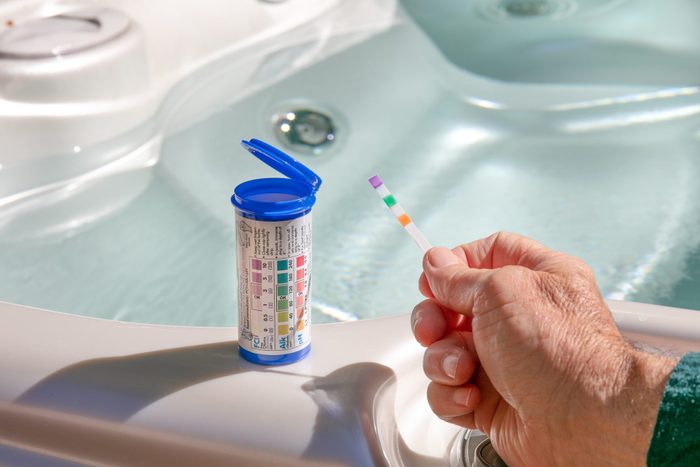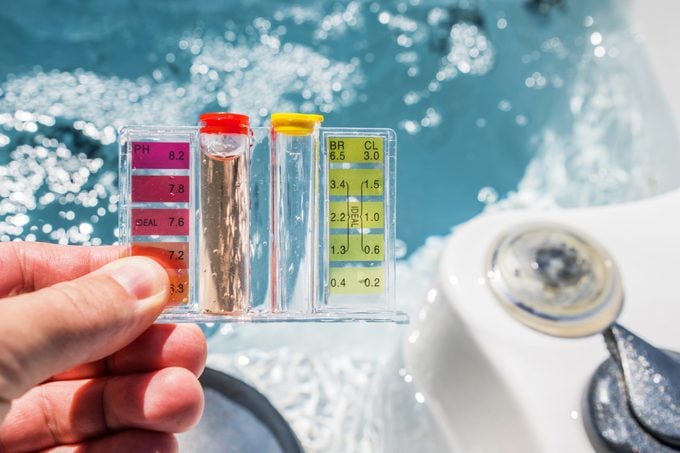Here’s How to Lower the Alkalinity in a Hot Tub
Updated: Feb. 23, 2024

High alkalinity in a hot tub can cause short- and long-term damage and limit your enjoyment of your tub. Here's how to lower alkalinity in a hot tub.
Your hot tub contains a relatively small amount of water, but it’s kind of like the ocean — you don’t want to turn your back on it. Neglecting the chemical balance of your hot tub can result in the need to drain and refill. But you can avoid that wasteful, costly step by staying on top of your hot tub’s chemical numbers, especially Total Alkalinity. Here’s a look at what hot tub alkalinity is, how it gets out of whack and how to lower alkalinity in a hot tub.
On This Page
What Is Hot Tub Water Alkalinity?
Alicia Toedter, education and content leader at Leslie’s Pool Supplies, explains that Total Alkalinity (TA) and pH are tightly linked elements in hot tub water chemistry. Keeping these two in a healthy relationship is critical for maintaining balanced water conditions and safe, clean, clear water.
“Simply put,” says Toedter, “TA is important because it controls the water’s ability to maintain pH levels and prevent rapid fluctuations. TA in the proper range acts as a buffer that keeps the pH from rising or falling when chemicals added to the water would normally make the pH go up or down.” Toedter adds that when TA is unbalanced, the pH level will not only fluctuate rapidly, but can also be difficult to get back into balance. “Imbalanced pH,” she says, “either high or low, can cause serious issues for hot tubbers and the hot tub itself.”
How To Check Hot Tub pH
Toedter says that even when hot tub water looks okay, there may be problems lurking. That’s why pros recommend testing your hot tub water two to three times a week and before each use, using an at-home test kit.
Home test kits are available as chemical test strips or liquid test kits.
- Chemical test strips test for several pool or hot tub chemicals and work by submersing the paper strip in the water per the instructions (usually just a few seconds). Less than a minute later, the different markers (bands) on the strip will change color. Compare these to the color key on the strip container, and you’ll see if and where your hot tub is off-balance.
- Liquid test kits, aka reagent kits, are considered a more accurate measure of pool chemicals, but they’re slightly more involved. With liquid kits, you capture a vial of hot tub water, add drops of testing agent to it, wait for the water to change color and compare it to the color key.
Both types of kits function to a point, says Toedter, but she adds that it’s important to have your hot tub or pool water professionally tested every few weeks for more precise results — usually by bringing a water sample to the pool supply store. Leslie’s, like many pool supply stores, offers this service free of charge.
Toedter says the ideal range for hot tub water pH and TA is 7.4 to 7.6 and 80 to 120 ppm, respectively, although this may vary slightly based on whether you use chlorine or bromine as a sanitizer.
What Happens if Hot Tub Water Alkalinity Is Too High?

While high TA in your hot tub may not be obvious at first, eventually it will make itself known in some unpleasant ways.
“pH is the measure of the acidity or basicity of the water,” says Toedter. “When water is too acidic, it can cause eye and skin irritation, damage to hot tub surfaces and equipment, and affect the longevity of your sanitizer. When water is too basic, it often causes scale buildup and cloudy water conditions, and can decrease sanitizer efficacy.” Because TA and pH are so interrelated, she says, “when TA is too high, your pH will most likely also be high.”
Visible signs of high TA or pH will start to appear as cloudy water, scale formation and possibly staining on hot tub surfaces. “Scale often appears as a white or off-white crusty residue on interior hot tub surfaces, typically along the water line,” says Toedter. Apart from aesthetics, scale can do real damage by building up in the hot tub’s plumbing, heater and filter. “Over time,” she says, “scale deposits can evolve into discolored stains, depending on the minerals, metals, body oils and other contaminants present in the water.”
What Causes High Alkalinity in a Hot Tub?
If you’re constantly battling high TA levels, it might not be your fault. Toedter says that the most common reason for high TA goes back to the source — the water you’re filling the tub with. “Certain water sources may have naturally higher TA levels,” she says.
And there’s another reason for high TA and pH that doesn’t seem fair: frequent use. “Aeration naturally drives the pH of the water higher, so using the jets and aerators on the hot tub will alter the water chemistry.”
How To Lower the Alkalinity in a Hot Tub
Lowering the TA in a hot tub involves adding chemicals specifically made to reduce that number. These are granular or liquid products that you pour into the hot tub after you’ve tested the water with test strips or a reagent kit, and only when the hot tub is turned off. Then turn the hot tub jets on and leave it to circulate, typically for around 30 minutes. Then test the water again, and repeat the process until you reach the right balance.
Toedter recommends using a TA reducer formulated specifically for hot tub use. “Do not use pool chemicals to address this issue, as they are often more potent and can damage the hot tub,” she says. “Only use chemicals if it states on the label that it’s suitable for use in hot tubs.” Once TA is in balance, this helps regulate the pH, too.
Leslie’s sells the following products to balance TA and pH in your hot tub water:
- Leisure Time Spa Down to lower both Total Alkalinity and pH.
- Leisure Time Alkalinity Increaser to raise Total Alkalinity with minimal impact on pH.
- Leslie’s Spa pH Up to raise both Total Alkalinity and pH.
